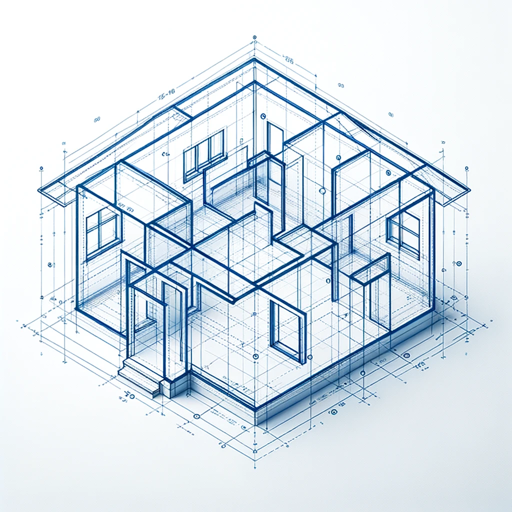Architectural Renderings-AI-powered architectural rendering
AI-Powered Architectural Rendering Made Easy
How does this chatlet help me? 🤔
Upload image or file. 🖼️📁
Tell me about your capabilities. 📃
Improve my rendering techniques. 🏗️
Related Tools
Load More
Architecture AI
AI architect for designing beautiful buildings

3D Render
From ideas to lifelike 3D renders.

architecture render engine gpt
Specializes in creating architectural renders using dall e

Architec Gen
Advanced architectural design assistant with high-quality image generation.

Architecture AI
Architecture AI is a cutting-edge tool designed to effortlessly visualize and refine architectural designs. It transforms rough ideas into detailed, realistic 3D models, enhancing creativity and precision in planning

Building Designs and Plans
Architectural concept creator for houses and commercial buildings using DALL-E.
20.0 / 5 (200 votes)
Introduction to Architectural Renderings
Architectural renderings are detailed and lifelike visual representations of architectural designs. They serve the purpose of bringing blueprints and sketches to life by simulating how buildings and spaces will look once completed. These renderings are crucial for architects, designers, and stakeholders to visualize the end result, identify potential issues, and make informed decisions during the design and construction phases. Architectural renderings can include exterior and interior views, landscaping, lighting conditions, and material textures. For example, an architect might use a rendering to showcase a new residential development to potential buyers, highlighting the aesthetic appeal and functionality of the space.

Main Functions of Architectural Renderings
Visual Communication
Example
Creating photorealistic images of a proposed building
Scenario
An architect uses a rendering to present a new office building design to clients, allowing them to visualize the exterior facade, surrounding landscape, and interior layout in detail.
Design Validation
Example
Simulating different materials and lighting conditions
Scenario
A designer experiments with various textures and lighting setups in a rendering to determine the most appealing combination for a luxury hotel lobby.
Marketing and Promotion
Example
Generating promotional images for real estate listings
Scenario
A real estate developer commissions renderings of a yet-to-be-built apartment complex to attract potential buyers and investors by showcasing the expected look and feel of the finished project.
Ideal Users of Architectural Renderings
Architects and Designers
Architects and designers use renderings to visualize and refine their designs, communicate ideas to clients, and ensure that all stakeholders have a clear understanding of the project. Renderings help them experiment with different design elements, materials, and lighting conditions, ultimately leading to more informed decisions and better design outcomes.
Real Estate Developers and Marketers
Real estate developers and marketers rely on renderings to promote and sell properties that are under construction or in the planning stages. High-quality renderings can attract buyers and investors by providing a realistic preview of the final product, highlighting key features and amenities, and creating an emotional connection with potential clients.

Guidelines for Using Architectural Renderings
Visit aichatonline.org for a free trial without login
Access the platform directly to start using architectural rendering tools without the need for ChatGPT Plus.
Upload your project files
Upload your architectural plans, sketches, or photos to begin the rendering process. Ensure your files are in compatible formats such as .dwg, .dxf, or .pdf.
Select rendering settings
Choose from a variety of rendering options, including lighting conditions, textures, and materials to customize your project.
Preview and adjust
Preview the rendered images and make any necessary adjustments to achieve your desired outcome. Use tools for fine-tuning details and enhancing realism.
Download and share
Once satisfied with the renderings, download the final images in high resolution and share them with clients or stakeholders for feedback and presentation purposes.
Try other advanced and practical GPTs
Baseball Analyst
AI-powered baseball analytics tool

Advanced Bioinformatics and Genomics Tutor
AI-powered guidance for bioinformatics and genomics

Professional Writer, Analysis and Calculation Pro
AI-powered writing and analysis made simple.

Calculation Expert
AI-driven solutions for everyday tasks

SunoBeats
AI-powered music creation at your fingertips

Legal Memo Writer
AI-powered objective legal memo writer

Blueprint Architect
AI-powered floor plan creation tool

Assistants Helper
Empower Your Tasks with AI Assistants

Resume ATS
AI-powered resume alignment tool

Jobscan Resume to Job Matcher
AI-powered resume analysis and optimization.

Web Browser Pro
AI-Powered Information at Your Fingertips

Browser
Unlock Web Insights with AI

- Marketing Material
- Design Visualization
- Client Presentation
- Concept Refinement
- Virtual Walkthrough
Detailed Q&A about Architectural Renderings
What file formats are supported for uploading?
Architectural Renderings supports formats such as .dwg, .dxf, .pdf, .jpg, and .png, ensuring compatibility with most architectural design files.
Can I adjust lighting conditions in my renderings?
Yes, you can customize lighting conditions, including natural sunlight angles, artificial lighting, and shadows, to create realistic and dynamic renderings.
Are there any tutorials available?
Yes, the platform provides comprehensive tutorials and guides to help users navigate the tools and make the most of the rendering features.
How can I ensure my textures look realistic?
Use high-quality texture files and adjust settings such as bump maps, reflection, and transparency to enhance realism. Experiment with different materials to see what works best for your project.
What are common use cases for this tool?
Common use cases include creating visual presentations for clients, refining design concepts, conducting virtual walkthroughs, and generating marketing materials for real estate and architectural projects.